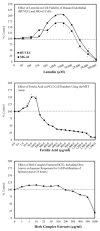Healthy Effects of Plant Polyphenols: Molecular Mechanisms
- PMID: 32070025
- PMCID: PMC7072974
- DOI: 10.3390/ijms21041250
Healthy Effects of Plant Polyphenols: Molecular Mechanisms
Abstract
The increasing extension in life expectancy of human beings in developed countries is accompanied by a progressively greater rate of degenerative diseases associated with lifestyle and aging, most of which are still waiting for effective, not merely symptomatic, therapies. Accordingly, at present, the recommendations aimed at reducing the prevalence of these conditions in the population are limited to a safer lifestyle including physical/mental exercise, a reduced caloric intake, and a proper diet in a convivial environment. The claimed health benefits of the Mediterranean and Asian diets have been confirmed in many clinical trials and epidemiological surveys. These diets are characterized by several features, including low meat consumption, the intake of oils instead of fats as lipid sources, moderate amounts of red wine, and significant amounts of fresh fruit and vegetables. In particular, the latter have attracted popular and scientific attention for their content, though in reduced amounts, of a number of molecules increasingly investigated for their healthy properties. Among the latter, plant polyphenols have raised remarkable interest in the scientific community; in fact, several clinical trials have confirmed that many health benefits of the Mediterranean/Asian diets can be traced back to the presence of significant amounts of these molecules, even though, in some cases, contradictory results have been reported, which highlights the need for further investigation. In light of the results of these trials, recent research has sought to provide information on the biochemical, molecular, epigenetic, and cell biology modifications by plant polyphenols in cell, organismal, animal, and human models of cancer, metabolic, and neurodegenerative pathologies, notably Alzheimer's and Parkinson disease. The findings reported in the last decade are starting to help to decipher the complex relations between plant polyphenols and cell homeostatic systems including metabolic and redox equilibrium, proteostasis, and the inflammatory response, establishing an increasingly solid molecular basis for the healthy effects of these molecules. Taken together, the data currently available, though still incomplete, are providing a rationale for the possible use of natural polyphenols, or their molecular scaffolds, as nutraceuticals to contrast aging and to combat many associated pathologies.
Keywords: Mediterranean diet; autophagy; curcumin; epigallocathechin; epigenetics; hormesis; hydroxytyrosol; oleuropein; olive oil; plant polyphenols; resveratrol.
Conflict of interest statement
The authors declare no conflict of interest
Figures





References
-
- Bach-Faig A., Berry E.M., Lairon D., Reguant J., Trichopoulou A., Dernini S., Medina F.X., Battino M., Belahsen R., Miranda G., et al. Mediterranean diet pyramid today. Science and cultural updates. Mediterranean Diet Foundation Expert Group. Public Health Nutr. 2011;14:2274–2284. doi: 10.1017/S1368980011002515. - DOI - PubMed
Publication types
MeSH terms
Substances
LinkOut - more resources
Full Text Sources
Other Literature Sources
Medical

